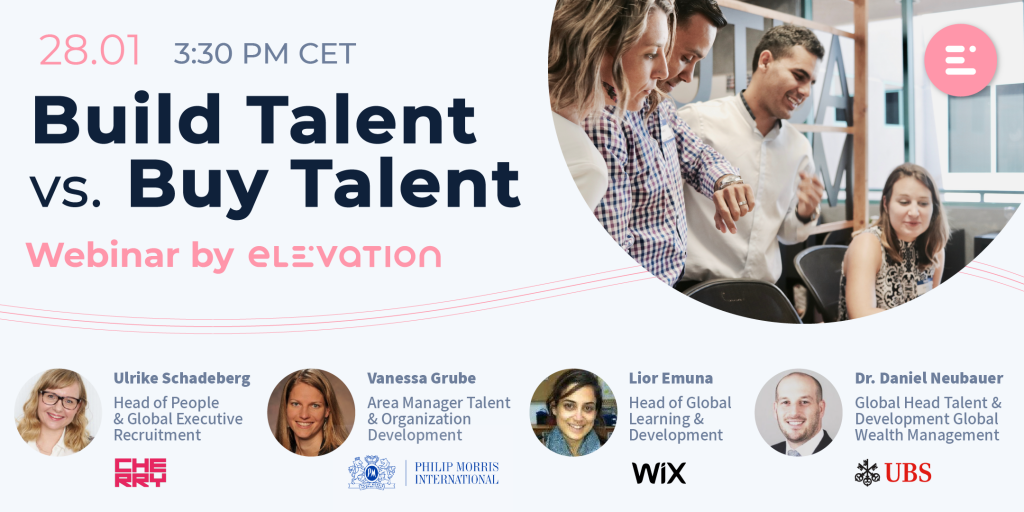When it comes to adding new skills and talents to an organization, HR, OD and L&D professionals are constantly confronted with the same question: should they invest in existing employees to develop skills internally or hire externally? There’s no clear answer, as each approach has its own distinct advantages and disadvantages. What’s more, the answer can change according to all sorts of factors that are often way beyond the control of the organization itself.
Our latest webinar — moderated by Karin Shalev-Shogol, GM of Elevation in Germany — touched upon these issues and more. We were honored to host dozens of enthusiastic participants from across the globe, alongside an all-star panel made up of HR experts from some of the world’s most successful and innovative enterprises.

Our four panelists included top HR executives from a wide range of companies and diverse industries including Wix.com, UBS, Philip Morris and Cherry Ventures. While each organization has its own specific approach to Learning and Development, everyone agreed that the advantages and benefits of building talent i.e., reskilling existing employees towards in-demand positions were hard to argue against.
Specifically, nearly every panelist agreed that building talent internally is critical to preserving a strong company culture that values its employees. Vanessa Grube from Philip Morris put it well when she said that, “…keeping people onboard helps to preserve the company culture.” That’s why at Philip Morris, the focus is always on building talent internally. However, she went on to say that in many cases, especially with tech positions, this isn’t always possible and that’s why they do hire externally.
Daniel Neubauer of UBS also touted employee engagement as another huge benefit of building talent. He said that, “it gives employees a sense that they can grow within the organization” and also claims that it isn’t about the skills an individual has, but rather about their attitude. Skills can be learned, but if there’s no desire to grow, then even the best reskilling program won’t help.
But sometimes there’s no choice but to hire externally. Ulrike Schadeberg of Cherry Ventures related that when skills don’t exist internally, or when a company is experiencing hyper growth and is opening new offices left and right, external hiring is the only way to go.
Lior Emuna from Wix said that during COVID-19 the company grew its headcount by nearly 300%. This means that new teams were built from scratch and they needed strong managers. What’s more, they expanded their offering to include new B2B business units that required functions that simply didn’t exist in the company before that. They had no choice but to hire account managers, sales executives and strong managers to fuel their growth.
However, with reskilling and L&D programs only recently gaining ground as strategic initiatives, questions abound regarding how organizations can leverage programs to support career advancement.
Vanessa Grube from Philip Morris feels that a two-pronged approach is best. At Philip Morris, they ask employees which skills they’re interested in learning and then check internally to see if there’s room in the organization for the employee to develop in that direction. Yet sometimes, they need to hire quickly or are looking for new skills. In those cases, they rely on the foundation they’ve already established. They check to see if there’s someone suitable internally while they test the waters externally to see how long it would take to find someone suitable.
But not all professions are suitable for reskilling. Here again, most panelists agreed that if the position requires internal knowledge to succeed, it’ll most likely go to an existing employee. Reskilling doesn’t have to be about a specific talent or skill but rather as part of a more general effort to prepare existing employees for the workplace of tomorrow.
As Daniel Neubauer of UBS said, “not everyone can be a data scientist.” He explained that at UBS, they’re trying to give their employees a foundation that they can build upon. According to Daniel, reskilling doesn’t have to be about specific skills but rather about preparing experts for the digital workplace.

The internal poll we ran regarding the right approach to steering L&D for employees shed some light on this subject. According to the poll, the overwhelming majority of respondents feel that reskilling programs should be matched to the employees’ interests instead of being aligned to specific gaps in the company.
There’s no doubt that there’s much to learn from the professionals dealing with L&D on a daily basis. As the skill gap widens and the tech shortage becomes more and more acute, organizations of every size are realizing that L&D programs are no longer just an employee benefit, but rather strategic initiatives with business impact that should be measured as such.







